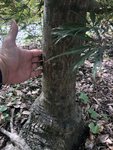CapeFear盆景
Sapling
A friend had this large maple garden tree he said I could air layer. I’ve never done an air layering of a maple and was hoping for some tips.
He also does not know how to prune the tree and is becoming a bit over grown. So my question is how do I prune such a large garden tree.
Also I’m not sure what which type this is. Any information would be appreciated.
Thank you
He also does not know how to prune the tree and is becoming a bit over grown. So my question is how do I prune such a large garden tree.
Also I’m not sure what which type this is. Any information would be appreciated.
Thank you




